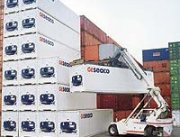
 Container transportation is not only the most modern type of cargo transportation, but also more economical. They are used both in domestic communication and internationally. A cargo container (container – English “container, vessel”) is a standard container for bulk transportation of goods by various means of transport and is immediately a container, a place for storing cargo and a unit of transport equipment for repeated use. Standard ISO 830-1981 for freight involves a container:
Container transportation is not only the most modern type of cargo transportation, but also more economical. They are used both in domestic communication and internationally. A cargo container (container – English “container, vessel”) is a standard container for bulk transportation of goods by various means of transport and is immediately a container, a place for storing cargo and a unit of transport equipment for repeated use. Standard ISO 830-1981 for freight involves a container:
– strong enough to be reusable –
– a special design, so that without intermediate unloading it is convenient to transport the cargo by one or more means of transport –
– equipped with devices for its quick overload, namely transfer from one mode of transport to another –
– made in such a way that it is easy to load, unload-
– having an internal volume of one m3 (35, three cubic feet) or more.
As it is necessary from the definition, the freight container is used as a removable body (body) of the vehicle (cars, wagons, ships, aircraft, etc.), which is adapted for mechanized loading, unloading and reloading from one type of transport to another. The dimensions and capacity of the containers correspond to the carrying capacity and the overall dimensions of the vehicle, strength and design ensure the safety of goods during transportation by one or more means of transport during the specified service life. Operation of containers is possible in the temperature range from –60 to +70 ° С.
Open side container equipped with side doors
Regardless of the purpose, all containers are standardized by gross weight, overall dimensions, connecting dimensions, as well as by the design of devices for mounting them on rolling stock of railway and road vehicles and to gripping bodies of loading and unloading machines. This makes it possible to carry out multimodal transportation by various means of transport, realizing the door-to-door principle known in logistics with minimal time and money.



